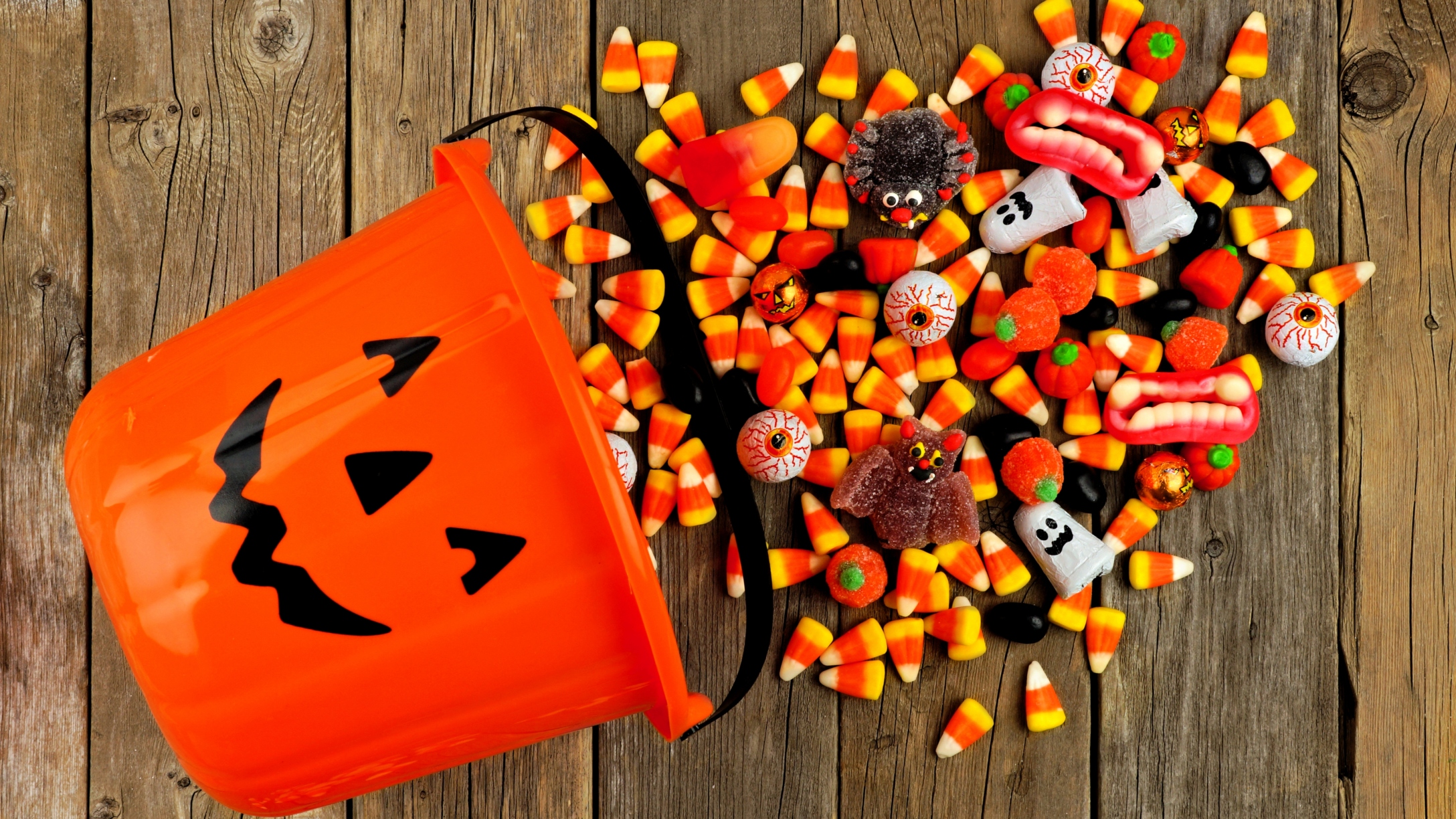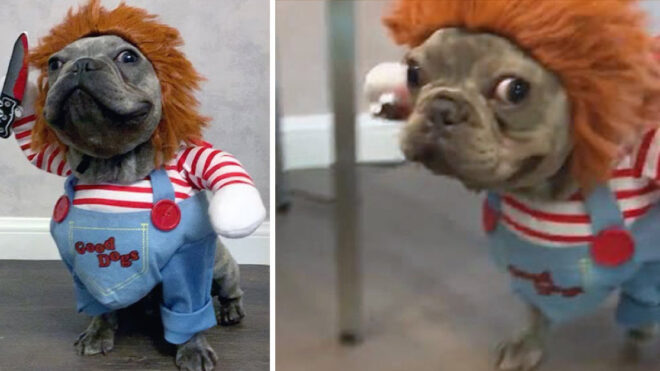
There are so many reasons to love Halloween! Spooky decorations are simply wonderful, scary movies are freakishly fun, and seeing little ones dressed up in all kinds of costumes can bring a smile to your face over and over again. And then there's the candy.
While you surely buy a box or two of treats to give out to the kids who show up at your door on October 31, many of us (or most of us?) pick up a few extra boxes of our personal favorites to nibble on leading up to and in the days after Halloween. Granted, it can be difficult to decide which candy to get for yourself. Do you go for classic chocolate bars, or do you prefer licorice? Of course, there are plenty of other yummy options like Tootsie Pops, Reese's Pieces, and candy corn.
Indeed, there are so many kinds of candy to adore, but the following facts about your favorite treats will make you love them even more! Keep reading to find out tasty trivia about candy corn and other Halloween treats.
Candy corn was made to look like chicken feed.
With its yellow, red, and white color pattern and distinctive shape, this sugary treat was meant to resemble pieces of chicken feed. In fact, if you carefully arrange the candy corn kernels in a certain way (like in the pic here), then you can see how it looks just like a cob of corn.
The Hershey Company prepares its Halloween chocolates five months in advance.
Popular candy brand The Hershey Company — which produces some of your favorite chocolate treats like Kit Kats, Reese’s Peanut Butter Cups, and the classic Hershey’s chocolate bars — never leave it to the last minute when it comes to preparing for Halloween. In fact, Anna Lingeris, senior manager of communications for The Hershey Company, told PennLive that production starts in the springtime so that the popular candies can show up in stores “in time for the transition to the fall season.”
Candy corn was invented around the 1880s.
People have been enjoying the sweet taste of candy corn for well over 100 years. According to the National Confectioners Association, candy corn was invented in the 1880s by George Renninger, who worked for the Wunderlee Candy Company. Now that is some yummy history!
Skittles are the United States' favorite Halloween candy.
Breaking down candy sales data from 2007 to 2019 in the months approaching Halloween, CandyStore.com was able to find out which Halloween candy Americans prefer. It turns out that those with a sweet tooth are seriously into the taste of the rainbow, as Skittles topped the list. Move over, candy apples!
Candy corn has its own day.
That’s right — candy corn is so beloved that there's an entire day dedicated to the sweet treat. Although candy corn is best known for being a staple on Halloween, National Candy Corn Day is actually celebrated on October 30, just before it's time to trick-or-treat.
'Fun-sized' candy bars were introduced in the 1930s.
For kids, it can be a joy to be given full-sized candy bars on Halloween. However, it's more likely that your little ones will be filling their trick-or-treating bags with smaller “fun-sized” versions. According to Tedium, the Curtiss Candy Company was the first to miniaturize its candy bars with the introduction of “junior” Baby Ruth chocolates as early as 1932.
Candy corn faces mixed reviews.
For a treat that's a Halloween staple, people sure are divided when it comes to how they feel about candy corn. In a survey done by CandyStore.com, the public ranked candy corn as the sixth favorite Halloween treat. However, in another survey of over 20,000 candy lovers, it topped the list of worst Halloween candies of all time. Where do you stand?
Tootsie Rolls were used in an unexpected way during the Korean War.
During the Korean War, American soldiers were sent a supply drop of the popular Halloween candy “after using the code name they’d established for artillery: Tootsie Rolls.” Not only did the chocolatey candy give soldiers a much-needed energy boost, but, according to Ripley’s, the candy was also used “to patch bullet holes in vehicles, hoses, and other equipment.”
It can take anywhere from 130 to 411 licks to reach the center of a Tootsie Pop.
In a 1970 commercial for Tootsie Pop, the ad dared to ask the question, “How many licks does it take to get to the Tootsie Roll center of a Tootsie Pop?” Since then, many studies have attempted to find the exact answer using volunteers and even customized licking machines. The results have varied from 130 to 411 licks. How many licks does it take you?
There are about 9 billion pieces of candy corn produced every year.
This fun Halloween treat has no trouble reaching the masses with “about 35 million pounds of candy corn (around 9 billion pieces) [being] produced each year,” according to the National Confectioners Association’s Susan Whiteside (via Vox). That is quite a mouthful!
The creator of Reese's Peanut Butter Cups named the treat after himself.
H.B. Reese was an employee of The Hershey Company way back in the 1920s when he started making his own candies. According to the Hershey Community Archives, his earlier chocolates had names like “Lizzie Bar” and “Johnny Bar,” which were nods to his children. But it was his invention of chocolate peanut butter cups that put him on the map, and the candies were later named Reese's Peanut Butter Cups after their creator.
The layer between the wafers of a Kit Kat bar isn't what you think it is.
Have you ever taken a break with a Kit Kat bar and wondered, “What is that chocolatey goodness keeping the wafers together?” Well, in a BBC Two episode of Inside the Factory, the hosts were told the secret as they toured the Nestlé factory. Apparently, broken pieces of unpackaged Kit Kat bars are ground up and used as the filling in between the wafers.
Butterfinger once made an energy bar.
Just in case a regular sugar high wasn’t enough to keep you going, there was a time when you could buy a caffeine-infused Butterfinger bar. Introduced for a limited time in 2009, Butterfinger Buzz burst onto the scene and boasted that it contained 80 mg of caffeine. The reviews definitely had people buzzing!
Apparently Gen Xers enjoy eating candy corn the most.
A survey was taken by the National Confectioners Association to find out which generation enjoys candy corn the most. According to the results, 58% of Gen Xers (those born between 1965 and 1980) enjoy the sugary snack the most, followed closely by 56% of baby boomers. However, only 46% of millennials (those born between 1981 and 1996) choose to indulge in the Halloween treat.
Pixy Stix was originally a drink powder.
Most recognizable in its striped straw-like packaging, Pixy Stix has been supplying kids with sugar rushes since 1952. However, the product can trace its roots even farther back to the 1930s when, according to Candy Favorites, the flavored sugar was originally a drink mix called Frutola. Pixy Stix changed from a drink to a simple sugary snack when inventor J. Fish Smith noticed kids were eating the product as-is.
There is a preferred way to eat candy corn.
Just like how there are many ways to eat corn on the cob, there are also various ways — including a favorite way — to munch on your candy corn. A survey done by the National Confectioners Association found that 7% of Americans eat the thick yellow end first, whereas 29% enjoy nibbling at the skinny white tip. On top of that, 65% prefer to just eat them all in one bite. Which do you prefer?
A Roald Dahl book inspired some of your favorite Halloween treats.
If you enjoy the sweet taste of Laffy Taffy, Runts, Sweetarts, Nerds, or Everlasting Gobstoppers, then you can thank author Roald Dahl. According to CandyStore.com, Quaker Oats bought the rights to a classic Dahl book to produce the 1971 film Willie Wonka & the Chocolate Factory in order to tie in a candy line. From there, the Wonka Candy Company was formed.
The original 3 Musketeers bar had three different flavors.
Created by the Mars Company, 3 Musketeers was released in 1932 and featured three small candy bars in one package. The flavors included chocolate, vanilla, and strawberry, and according to Penn State, the candy cost only 5 cents. However, when sugar was being rationed during World War II, the company decided to narrow it down to a single chocolate flavor.
Warheads are one of the sourest candies around.
Your little ones' Halloween sacks might be filled with chocolate bars, gummy goodies, and salty snacks, but lurking in the mix could be something that packs a punch. Warheads are small candies that pack a super-sour taste. With a combination of citric, ascorbic, and malic acids, it's no wonder that they have landed on several Most Sour Candy lists.
Candy corn has zero grams of fat.
Candy corn does not contain any fat, but that doesn’t mean that you can start sprinkling those little wonders into your next kale salad. In fact, according to the nutritional facts listed by Brach’s Candy, each piece of candy corn contains about 1.47 grams of sugar, 3.67 mg of sodium, and 7.3 calories.
Ring Pops were originally invented to prevent thumb-sucking.
Ring Pops are a classic blend of fashion and sugar that not only are loved by kids but also have been enjoyed on special occasions by celebrities like Sophie Turner and Joe Jonas. However, when these sweet suckers were invented by Frank Richards, he was originally trying to get his daughter to break a thumb-sucking habit, according to Candy Favorites. You never know when or how inspiration will hit!
There are many varieties of candy corn.
Although candy corn is mostly recognized as a Halloween treat in the classic form, it has also branched out to different holidays and different flavors. Over the years, candy corn has evolved to include such flavors as Maple, S’Mores, Pie, and Sparkling Cupid Corn for Valentine’s Day, as well as Reindeer Corn for Christmas.
Dubble Bubble gum is pink because that was the only dye available at the time.
Out of all the colors in the world, how was it that the first bubble gum came to be pink? Well, the recipe was created accidentally by an accountant named Walter E. Diemer who worked at the Fleer Company in 1928. According to Gumball.com, Diemer was playing with the recipe to make it less sticky, and when it came to adding food coloring, pink was the only option around.
Each Skittle color does have its own unique flavor.
In 2018, NPR explored whether or not different-colored Skittles were actually different flavors or just unique colors all with the same taste. A spokesperson for Mars Wrigley Confectionery responded via Today, claiming that “each of the five fruity flavors in Skittles has its own individual taste and flavor.” What do you think?
The coating on your favorite candy corn is made from bugs.
If you need a minute to process this new information, we understand. According to Tech Insider, the coating on candy corn is made from lac-resin. Sounds harmless enough, until you find out that lac-resin is “an insect secretion from lac bugs found in Asia.” Ummm, no thanks.
Reese's Pieces weren't Steven Spielberg's first choice for 'E.T.'
In the iconic film E.T. the Extra-Terrestrial, which is set around Halloween, the lovable alien adores Reese’s Pieces. However, that specific treat wasn’t director Steven Spielberg’s first choice. According to The Washington Post, those behind the scenes reached out to M&M's and offered the company a product “tie in,” but they were turned down. Instead, the moviemakers went with Reese's Pieces, a decision that benefited The Hershey Company, as sales of the candy jumped “70 percent [one month after] the film was released.”
Candy corn used to be made by hand.
When candy corn was first being introduced to the market by the Goelitz Confectionery Company (now Jelly Belly) in 1898, it was made painstakingly by hand. CEO of Jelly Belly Lisa Brasher told USA Today that the candy was made using “open copper kettles over an open flame … one for the white tip of the corn, one for the orange center of the corn, and one for the yellow top of the corn.” Now, that’s dedication!
Milky Way bars were not named for our galaxy.
There’s no need to look to the stars if you’re trying to figure out the inspiration behind a Milky Way bar. It turns out that the chocolatey caramel confectionary that was introduced in 1923 was instead inspired by the “chocolate-malt milkshake that was popular at the time,” according to OldTimeCandy.com.
Candy corn is kosher.
Jelly Belly, one of the original manufacturers of candy corn, proudly states that its product and, in fact, all of its mellocreme candies are “certified OU Kosher, the only OU product on the market.” According to OU Kosher, that means that it's “fit or proper as it relates to Jewish dietary law.”
Some Halloween candies can last up to two years.
Did your kids come home with way too much Halloween candy? Well, don’t feel like you have stuff all those sweets in your mouths at one time, because some of your favorite treats can last a lot longer than you might think. Reader’s Digest states that softer candies like peanut butter cups may last anywhere from six to nine months, and dark chocolates can last up to two years.







